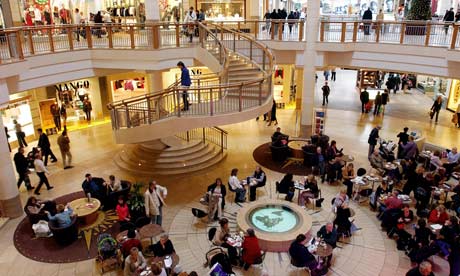Out-of-town shopping malls suffer as fuel price deters shoppers
John Lewis reveals sales plunge in stores at Bluewater and Cribbs Causeway, in contrast to traditional shops

Bluewater shopping centre, where takings at the John Lewis store have declined more than 9% since the end of January. Photograph: Martin Godwin for the Guardian
Soaring petrol prices are hitting sales at out-of-town shopping centres as cash-strapped consumers think twice about making long journeys to retail destinations such as Cribbs Causeway in Bristol and the Metrocentre in Gateshead.
As the price of oil breached $124 a barrel for the first time in two and a half years – and is now at a record in sterling terms, as a result of the weaker pound – John Lewis revealed big sales declines at its shops in key out-of-town malls, including Bluewater in Kent and Cribbs Causeway.
Takings at the retailer's Bluewater department store are down more than 9% since the end of January, with the decline accelerating to more than 12% in the most recent week. At the John Lewis store in Cribbs Causeway mall sales have tumbled more than 11% so far this year and were down more than 14% last week.
City retail analyst Freddie George, at brokers Seymour Pierce, said: "With the petrol price so high, we knew this was coming and these John Lewis figures provide the first significant evidence."
The dismal sales at John Lewis's out-of-town centres are in sharp contrast to its more traditional city centre branches and internet site.
Retail research group Synovate, which monitors the number of shoppers visiting retail centres nationwide, said it had also detected a move for shoppers to stay local. The number of shoppers going through the doors of out-of-town centres fell nearly 12% in March, compared with last year, and compared with a 7% decline across all shops.
With the price of oil predicted to hit $130 later this year, the cost of petrol is likely to climb even higher. Over the past year it has leaped by some 21p to its current level of around 134p a litre. Analysts say further increases will accelerate the move away from out-of-town centres as shoppers baulk at rising petrol costs.
Tim Denison, director of retail intelligence at Synovate Retail Performance, said: "If petrol prices remain high, there is likely to be some kind of structural shift, with people going to out-of-town centres less frequently and spending more time there when they do. We would expect more promotion from the out-of-town centres, possibly by providing free bus services to customers, rather than expecting them to come in under their own steam."
The average shopper turning up at a regional mall like Meadowhall or Bluewater has driven around 32 miles, according to CACI, another retail research group. A shopper who decides to stay local instead will therefore save about £12 in petrol costs for the round trip. Jonathan De Mello, of property agents CB Richard Ellis, said history showed small out-of-town centres tend to suffer from rising petrol prices but that the larger ones actually benefit as shoppers ensure they visit a site "where everything is under one roof". John Lewis played down the impact of rising petrol prices, arguing that the weather and timing of bank holidays were more significant. Nat Wakely, director of selling operations at John Lewis, said the equivalent period for last year included Good Friday, a day when city centre workers tend to avoid high street outlets in favour of a day out at an out-of-town mall.
Motorists are cutting back on journeys in order to save money, according to an AA poll in January. Edmund King, the AA president, said short car journeys are less fuel-efficient because they involve stop-start driving and trips to shopping centres could fall victim to a domestic cost squeeze. "If the journey to the out-of-town shopping centre is on average five or six miles that is a particularly inefficient journey in terms of fuel use. So if people can avoid that, they will."
Although John Lewis's more central stores tended to perform better than its out-of-town sites, the latest data from the group showed times remain tough on the high street.
Reporting at the end of a week that saw Halfords and Carpetright becoming the latest retailers to issue profits warnings, John Lewis revealed that it too was suffering from British consumers' dwindling confidence and purchasing power. The John Lewis department stores recorded year-on-year sales growth of just 1.1%, including the benefit of the January VAT rise, well down on the near-10% increase seen in the previous six months.
No comments:
Post a Comment